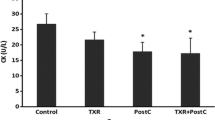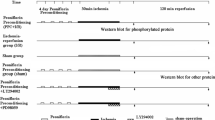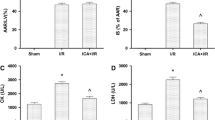Abstract
High mobility group box 1 protein (HMGB1) plays an important role in myocardial ischemia and reperfusion (I/R) injury. Preconditioning of exendin-4 (Ex), a glucagon-like peptide-1 receptor agonist, has been reported to attenuate myocardial I/R injury. The current study investigated whether Ex postconditioning also attenuated myocardial I/R injury and the potential mechanisms. Anesthetized male rats were subjected to ischemia for 30 min and treated with Ex (5 μg/kg, i.v.) 5 min before reperfusion, in the absence and/or presence of exendin (9–39) (an antagonist of glucagon-like peptide-1 receptor, 5 μg/kg, i.v.), followed by reperfusion for 4 h. Lactate dehydrogenase (LDH), creatine kinase (CK), tumor necrosis factor-α, interleukin-6, and infarct size were measured. HMGB1 expression was assessed by immunoblotting. Postconditioning with Ex significantly decreased infarct size and levels of LDH and CK after 4 h reperfusion (all p < 0.05). Ex also significantly inhibited the increase in malondialdehyde level and decreased the level of superoxide dismutase (both p < 0.05). In addition, the increase in HMGB1 expression induced by I/R was significantly attenuated by Ex postconditioning. Administration of exendin (9–39) abolished the protective effect of Ex postconditioning (all p < 0.05). The present study suggests that Ex postconditioning may attenuate myocardial I/R injury, which may in turn be associated with inhibiting inflammation.




Similar content being viewed by others
References
Frangoginis NG, Smith CW, Entman ML (2002) The inflammatory response in myocardial infarction. Cardiovasc Res 53:31–47
Gottlieb RA, Engler RL (1999) Apoptosis in myocardial ischemia-reperfusion. Ann N Y Acad Sci 874:412–426
Scaffidi P, Misteli T, Bianchi ME (2002) Release of chromatin protein HMGB1 by necrotic cells triggers inflammation. Nature 418:191–195
Bell CW, Jiang W, Reich CF et al (2006) The extracellular release of HMGB1 during apoptotic cell death. Am J Physiol Cell Physiol 291:C1318–C1325
Andrassy M, Volz HC, Igwe JC et al (2008) High-mobility group box-1 in ischemia-reperfusion injury of the heart. Circulation 117:3216–3226
Hu X, Jiang H, Bai Q et al (2009) Increased serum HMGB1 is related to the severity of coronary artery stenosis. Clin Chim Acta 406:139–142
Andrassy M, Volz HC, Riedle N et al (2011) HMGB1 as a predictor of infarct transmurality and functional recovery in patients with myocardial infarction. J Intern Med 270:245–253
Zhao D, Wang Y, Xu Y (2012) Decreased serum endogenous secretory receptor for advanced glycation endproducts and increased cleaved receptor for advanced glycation endproducts levels in patients with atrial fibrillation. Int J Cardiol 158:471–472
Hu X, Fu W, Jiang H (2012) HMGB1: a potential therapeutic target for myocardial ischemia and reperfusion injury. Int J Cardiol 155:489
Kieffer TJ, Habener JF (1999) The glucagon-like peptides. Endocr Rev 20:876–913
Bose AK, Mocanu MM, Carr RD et al (2005) Glucagon-like peptide 1 can directly protect the heart against ischemia/reperfusion injury. Diabetes 54:146–151
Sokos GG, Nikolaidis LA, Mankad S et al (2006) Glucagon-like peptide-1 infusion improves left ventricular ejection fraction and functional status in patients with chronic heart failure. J Card Fail 12:694–699
Sonne DP, Engstrom T, Treiman M (2008) Protective effects of GLP-1 analogues exendin-4 and GLP-1(9-36) amide against ischemia-reperfusion injury in rat heart. Regul Pept 146:243–249
Okerson T, Chilton RJ (2012) The cardiovascular effects of GLP-1 receptor agonists. Cardiovasc Ther 30:e146–e155
Cai Y, Hu X, Yi B et al (2012) Glucagon-like peptide-1 receptor agonist protects against hyperglycemia-induced cardiocytes injury by inhibiting high mobility group box 1 expression. Mol Biol Rep 39:10705–10711
Wu L, Olverling A, Huang Z et al (2012) GLP-1, exendin-4 and C-peptide regulate pancreatic islet microcirculation, insulin secretion and glucose tolerance in rats. Clin Sci 122:375–384
Zhang K, Wu Y, Zhao L et al (2013) Exendin-4 attenuates ischemia-induced ventricular arrhythmias in rats. Cardiol J 20:29–33
Hu X, Cui B, Zhou X et al (2012) Ethyl pyruvate reduces myocardial ischemia and reperfusion injury by inhibiting high mobility group box 1 protein in rats. Mol Biol Rep 39:227–231
Timmers L, Henriques JPS, de Kleijn DPV et al (2009) Exenatide reduces infarct size and improves cardiac function in a porcine model of ischemia and reperfusion injury. J Am Coll Cardiol 53:501–510
Hu X, Zhou X, He B et al (2010) Minocycline protects against myocardial ischemia and reperfusion injury by inhibiting high mobility group box 1 protein in rats. Eur J Pharmacol 638:84–89
Andersson U, Wang H, Palmblad K, Aveberger AC, Bloom O, Erandsson-Harris H, Janson A, Kokkola R, Zhang M, Yang H, Tracey KJ (2000) High mobility group 1 protein (HMG-1) stimulates proinflammatory cytokine synthesis in human monocytes. J Exp Med 192:565–570
Inoue K, Kawahara KI, Biswas KK, Ando K, Mitsudo K, Nobuyoshi M, Maruyama I (2007) HMGB1 expression by activated vascular smooth muscle cells in advanced human atherosclerosis plaques. Cardiovasc Pathol 16:136–143
Kawahara K, Biswas KK, Unoshima M et al (2008) C-reactive protein induces high mobility group box-1 protein release through activation of p38MAPK in macrophage RAW264.7 cells. Cardiovasc Pathol 17:129–138
Hausenloy DJ, Yellon DM (2006) Survival kinases in ischemic preconditioning and postconditioning. Cardiovasc Res 70:240–253
Hu X, Xu C, Zhou X et al (2011) PI3K/Akt signaling pathway involved in cardioprotection of preconditioning with high mobility group box 1 protein during myocardial ischemia and reperfusion. Int J Cardiol 150:222–223
Erdogdu O, Eriksson L, Xu H et al (2013) Exendin-4 protects endothelial cells from lipoapoptosis by PKA, PI3K, eNOS, p38 MAPK, and JNK pathways. J Mol Endocrinol 50:229–241
Acknowledgments
This study was partially supported by a grant from the National Natural Science foundation of China (No. 81100146 and 81370308), Grant 111023 from the Fundamental Research Funds for the Central Universities, the Specialized Research Fund for the Doctoral Program of Higher Education of China (No. 20110141120060), and the Fundamental Research Funds of Wuhan City (No. 2013070104010044).
Conflict of interest
None.
Author information
Authors and Affiliations
Corresponding authors
Rights and permissions
About this article
Cite this article
Du, X., Hu, X. & Wei, J. Anti-inflammatory effect of exendin-4 postconditioning during myocardial ischemia and reperfusion. Mol Biol Rep 41, 3853–3857 (2014). https://doi.org/10.1007/s11033-014-3252-0
Received:
Accepted:
Published:
Issue Date:
DOI: https://doi.org/10.1007/s11033-014-3252-0




